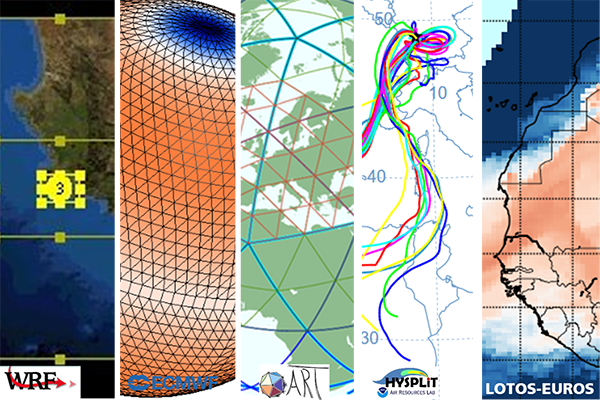Models at Fraunhofer IOSB
The Weather Research and Forecasting (WRF) model is a next-generation mesoscale numerical weather prediction system (Skamarock et al. 2019) designed for both atmospheric research and operational forecasting applications. It features two dynamical cores, a data assimilation system, and a software architecture that supports parallel computations and system extensions. The model serves a wide range of meteorological applications on scales from tens of meters to thousands of kilometers.
The LOTOS-EUROS model is a 3D chemical transport model for simulating air pollution in the lower troposphere. The model has been used in a large number of studies to assess particulate air pollution and trace gases (e.g. O3, NO2) (e.g. Manders et al 2009, Hendriks et al, 2013, Curier et al, 2012, 2014, Schaap et al 2013). The model has frequently participated in international model comparisons on ozone (e.g., Solazzo et al. 2012a) and particulate matter (e.g., Solazzo et al. 2012b, Stern et al. 2008). For a detailed description of the model and for references not found in the reference section of this document, we refer the reader to Schaap et al. (2008).
The ICON-ART (global) model system is characterized by the online coupling of the DWD NWP models with the ART modules developed at the Karlsruhe Institute of Technology (KIT) for the treatment of aerosols and reactive trace gases in the atmosphere (Riegel et.al. 2015).
Application
Specifically, the numerical weather prediction simulations are supplemented with the prediction of the concentrations of selected aerosols and, if required, gaseous components. The corresponding balance equations are solved at each time step and at all points of the computational grid. As an advantage of online coupling, the meteorologically relevant parameters treated by the additional processes can be used with a high update frequency synchronously with the numerical weather forecast. Moreover, the treatment of grid-scale (advection) and sub-grid-scale (convection, turbulent diffusion) transport processes for the additional tracers is performed with the same algorithms and operators as used, for example, for the treatment of specific humidity variables in the pure NWP model. Specific processes such as emission, sedimentation, wet and dry deposition at the surface, or transformation processes such as chemical transformation are provided by the ART modules.
Regarding the interactions between meteorological processes and the trace substances (aerosol-radiation or aerosol-cloud feedback mechanisms), it is generally possible to address them in an online coupled model.
 Fraunhofer Institute of Optronics, System Technologies and Image Exploitation IOSB
Fraunhofer Institute of Optronics, System Technologies and Image Exploitation IOSB 